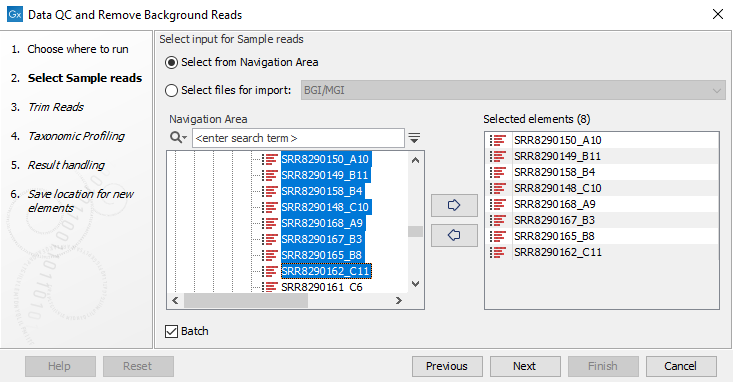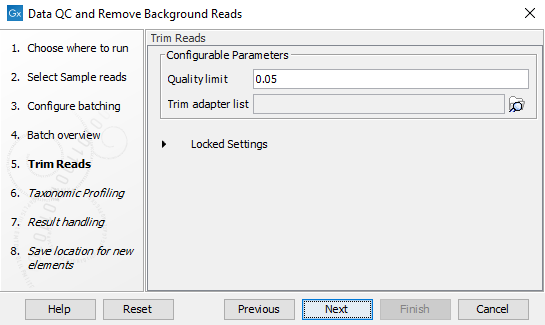Data QC and Remove Background Reads
The Data QC and Remove Background Reads workflow performs trimming of reads, creates a QC report and cleans the dataset from background DNA, leaving back only the reads that match the reference genome(s).
To run the Data QC and Remove Background Reads workflow, go to:
Toolbox | Template Workflows (![]() ) | Microbial Workflows (
) | Microbial Workflows (![]() ) | Metagenomics (
) | Metagenomics (![]() ) | Taxonomic Analysis (
) | Taxonomic Analysis (![]() ) | Data QC and Remove Background Reads (
) | Data QC and Remove Background Reads (![]() )
)
You can select only one read file to analyze (figure 3.11). Alternatively, multiple files can be run using the batch mode.

Figure 3.11: Select the reads. Use Batch mode if you have more than one set of reads.
In the "Trim Sequences" dialog, you can specify a trim adapter list and set up parameters if you would like to trim your sequences from adapters (figure 3.12).

Figure 3.12: You can choose to trim adapter sequences from your sequencing reads.
The parameters that can be set are:
- Quality limit: defines the minimal value of the Phred score for which bases will not be trimmed.
- Trim adapter list: the adapter sequences to trim (if any).
In the Taxonomic Profiling dialog, select the "Species of interest taxpro index" you will use to map the reads (figure 3.13). Here, you can also choose to "Filter background reads". You must then specify the "Background taxpro index" (in the case of human microbiota, the Homo sapiens GRCh38 for example). The reference database can be obtained by using the Download Curated Microbial Reference Database tool (Download Curated Microbial Reference Database) or Download Custom Microbial Reference Database tool (Download Custom Microbial Reference Database). The host index and (if using the custom downloader) the microbial reference index are built with the Create Taxonomic Profiling Index tool (Create Taxonomic Profiling Index).

Figure 3.13: Select the reference databaes, and potentially a background taxpro index to remove possible contamination.
The workflow will output three sequence lists:
- Trimmed, cleaned reads: trimmed reads mapping to the species of interest taxpro index of reference genome(s).
- Background reads: reads mapping to the background taxpro index.
- Unmapped reads: reads not mapping to the species of interest or the background taxpro index.
For the trimming report, see http://resources.qiagenbioinformatics.com/manuals/clcgenomicsworkbench/current/index.php?manual=Trim_output.html.
